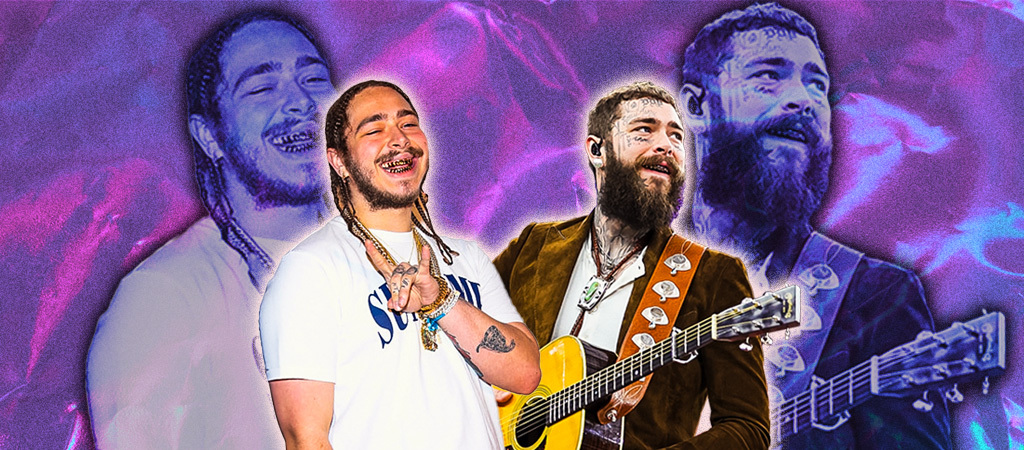
This Friday, chameleonic pop star Post Malone is releasing his first-ever country album, F-1 Trillion. While his output from this project has so far — singles such as the Blake Shelton-featuring “Pour Me A Drink,” the Morgan Wallen collab “I Had Some Help,” and “Guy For That” with Luke Combs — been fairly warmly received, there are some listeners who have regarded (rightly, it must be said) the Dallas singer’s swing from hip-hop-courting crooner to burgeoning country star with skepticism. The ease and speed with which he’s made this pivot begs the question: Was Post Malone ever really a rapper to begin with?
After all, in the minds of many music fans, his genre turn only culminates the character arc some of us predicted from the very first moment he stepped into the spotlight, with 2015’s “White Iverson.” Remember Posty’s “White Iverson” era, when he was adorned with all the accoutrements of a rapper, from cornrows and gold grills to lingo that suggested he’d be more likely to be seen at the local lowrider show than a Texas rodeo? Back then, he fielded all sorts of accusations of cultural appropriation, which only strengthened defenses for his right to present himself however he felt most comfortable. And now, he alternates cowboy and trucker hats, sports plaid button-ups and dungarees, and even threw on a bolo tie at the CMAs.
We want to be sensitive and fair here. Post recently admitted that early categorizations as a “culture vulture” had a negative impact on him, and out of respect for that, we can’t cast aspersions on his intentions with “White Iverson” and Stoney-era follow-ups like “Congratulations” (featuring Quavo), “Rockstar” (featuring 21 Savage), or “Psycho” (featuring Ty Dolla Sign). But it’s hard not to look at Post Malone’s early output and image and compare them to his five-year evolution from the sort of artist who’d unironically brag, “I’m with some white girls and they lovin’ the coca,” to the time-honored tradition of comparing the repair of a broken heart to fixin’ up a pick-up truck.
It’s especially difficult in light of those comments he once made about hip-hop. “If you’re looking for lyrics, if you’re looking to cry, if you’re looking to think about life, don’t listen to hip-hop,” he told a Polish outlet during a 2017 interview. “There are great hip-hop songs where they talk about life and they spit that real sh*t, but right now, there’s not a lot of people talking about real sh*t. Whenever I want to cry, whenever I want to sit down and have a nice cry, I’ll listen to some Bob Dylan.” While he later posited the soundbite was taken out of context, the damage had been done; he was considered a hip-hop outsider who only used the culture to gain a foothold on the spotlight and discarded it as readily as he was accepted into the culture by collaborators like Young Thug, Travis Scott, Roddy Ricch, and those mentioned above.
It has been seven years since those comments, and it’d be fair to allow for growth of both his worldview and his taste in music. But maybe he never should have been considered a rapper in the first place, just because he had braids and a song comparing himself to a hip-hop icon. When you look at songs like “White Iverson,” it’s not like he was out here quoting Rakim or giving J. Cole a run for his money. Hell, there are so-called “mumble rappers” with more cohesive verses than the clump of strung-together clichés that comprise “White Iverson”‘s most rapperly bars, which are mostly delivered in a singsong hum — he’s always been more of a “singer whose lyrics are informed by rap” than a stand-up rapper.
Complicating matters is Post’s acceptance into the country world, with so many co-signs from country stars up to and including the queen herself, Dolly Parton, where artists like Beyoncé and Lil Nas X were held at arm’s length. Even Beyoncé’s supposed overture to the country establishment, Cowboy Carter, was met with pushback that we never really saw for Post Malone; “Texas Hold ‘Em” was initially rejected from country radio playlists, while “I Had Some Help” was readily accepted (whether this was due to the inclusion of Morgan Wallen is impossible to determine, but sonically, there was just no argument for the reluctance to include “Texas Hold ‘Em”). For what it’s worth, Dolly popped up on Beyoncé’s album too, even granting her permission to remake her signature song, “Jolene,” so that’s not to say that Bey was entirely rejected by country’s gatekeepers.
But Beyoncé undoubtedly had a harder time being accepted into country music’s hallowed halls than Posty had in either hip-hop or country — and this despite not really being much of a rapper in the first place. We shouldn’t begrudge any artist expressing themselves how they see fit, whether that’s leaving the box we’ve designed for them or jumping into a new one. But maybe we shouldn’t be so quick to classify them in the first place. Beyoncé could just be a singer, not a pop one, not an R&B one, but a singer capable of creating in any genre. And maybe, if we’re going to let some rappers cross over more easily than others, we need more stringent standards on just what constitutes a rapper in the first place.
